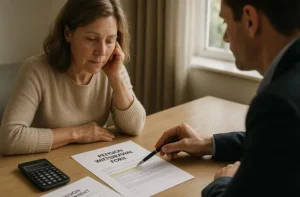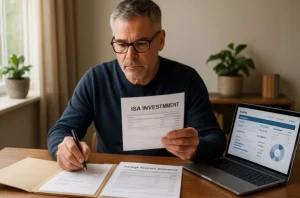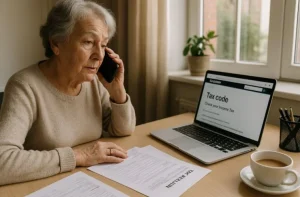How to Avoid Paying Tax on Your Pension? | Smart Legal Ways

Retirement should be a time of financial comfort, not tax confusion. After years of diligent saving into pensions, many people in the UK expect their retirement income to flow freely, only to discover it’s still taxable.
Without careful planning, withdrawing money from your pension pot can lead to unexpected tax charges, reducing the income you rely on. But there is good news.
There are completely legal, strategic ways to reduce or even avoid paying tax on your pension, if you understand the system and plan accordingly.
This guide walks you through how to minimise your pension tax bill in 2025 and beyond, offering real-world examples, clear explanations, and step-by-step methods based on current UK regulations.
What is Taxable and What’s Tax-Free in Your Pension Income?

Understanding what part of your pension is taxable is the foundation for planning an efficient retirement income. In the UK, most pension income is subject to income tax, but there are clear exceptions and allowances that let you keep more of your money.
The Personal Allowance and Your Pension
The Personal Allowance is the amount of income you’re allowed to receive each tax year before paying any income tax. As of the 2025/26 tax year, this stands at £12,570 for most people.
If your total income, including pension withdrawals, the State Pension, and any additional income such as rental income or dividends, remains under this threshold, you won’t owe any income tax at all.
However, once you cross this threshold, any further income becomes taxable. For example, income between £12,571 and £50,270 is taxed at the basic rate of 20%, while income above that moves into the higher rate (40%) and additional rate (45%) tax bands.
State Pension and Private Pensions
The State Pension is paid out before tax is deducted, but it’s still taxable income. If it is your only source of income, and you receive the full £11,973 State Pension, you’ll still be under the Personal Allowance and won’t pay tax. However, if you have other income streams, your total income could easily exceed the allowance.
Private pensions, such as defined contribution or workplace pensions, are also taxable, except for the first 25% of your pension pot, which you can take tax-free. This tax-free portion is known as the Pension Commencement Lump Sum (PCLS).
The maximum amount you can take tax-free is £268,275, which equates to 25% of the previous Lifetime Allowance that was abolished in 2023. This amount is fixed and can’t grow with inflation, so it’s important to plan your withdrawals to make the most of it.
How is Tax Collected from Your Pension Withdrawals?
Once you start withdrawing money from your pension, the government collects income tax through a process similar to how it is done during employment, usually through the PAYE (Pay As You Earn) system. Your pension provider deducts the tax and sends it directly to HMRC.
The Role of Tax Codes
When you begin taking income from your pension, HMRC assigns a tax code that tells your provider how much tax to deduct.
If you haven’t taken any taxable income in the current tax year or haven’t provided your P45 from your previous employer, you may be assigned an emergency tax code.
This can result in an overpayment of tax because HMRC might treat your first pension withdrawal as if it’s a monthly recurring payment.
While this overpaid tax can usually be reclaimed at the end of the year or through a direct refund from HMRC, it can be a frustrating experience, especially if you’re relying on the funds for essential expenses.
To avoid this, it’s wise to submit the correct paperwork and confirm your tax code with HMRC before making a large withdrawal.
How to Avoid Paying Tax on Your Pension? – Step by Step
Avoiding pension tax doesn’t mean doing anything illegal, it simply means understanding how pension income is taxed and making informed decisions about when and how to access your funds.
Step 1: Keep Income Below Your Personal Allowance

The simplest way to avoid paying income tax on your pension is to ensure that your total income remains under £12,570 in a given tax year. This includes the State Pension and any other income sources such as rental income or dividends.
If you structure your withdrawals carefully, you can remain under this threshold and avoid paying tax altogether.
Step 2: Use Your 25% Tax-Free Lump Sum Strategically

Rather than taking the 25% tax-free lump sum in one go, you can phase it over time. This is especially useful if you want to combine it with taxable income without pushing yourself into a higher tax band.
Each time you make a withdrawal under flexi-access drawdown, 25% of that amount can be tax-free, allowing you to gradually draw your pension while maintaining tax efficiency.
Step 3: Limit Withdrawals to What You Need
It might be tempting to take out a large sum when you retire, but doing so could land you in a higher tax bracket unnecessarily.
If you only withdraw what you need for your current lifestyle, and leave the rest invested, your money can continue to grow and you’ll avoid unnecessary taxation.
Step 4: Use ISAs First

If you have money saved in ISAs, it makes sense to draw income from these before touching your pension.
Income and capital gains from ISAs are tax-free and don’t count towards your personal allowance, so using these first can help delay pension withdrawals and manage your tax position.
Step 5: Avoid Emergency Tax Traps

To prevent overpaying tax on your first pension withdrawal, ensure your provider has the correct tax code. Providing your P45 or requesting a revised tax code from HMRC before making a large withdrawal is an easy step that can save you money.
What Are the Risks of Taking Your Entire Pension at Once?
Taking your full pension in one go may sound appealing, especially if you have plans to buy a home, clear debts, or gift money to family. However, this approach often comes with an unexpected downside: a significantly higher tax bill.
The UK’s tax system is progressive, meaning the more income you withdraw in a single tax year, the more tax you’re likely to pay.
While 25% of your pension pot is tax-free, the remainder is treated as taxable income and added on top of any other income you receive, such as the State Pension.
Let’s consider the real-life case of Martin, a 62-year-old retiree from Manchester with a defined contribution pension pot worth £100,000. He’s recently retired and plans to withdraw the full amount in one go.
First, he receives 25% tax-free, which is £25,000. That part incurs no tax. The remaining £75,000 is added to his other income, which includes the full State Pension of £11,973.
So, Martin’s total taxable income in this tax year is:
| Source | Amount |
|---|---|
| State Pension | £11,973 |
| Taxable pension withdrawal | £75,000 |
| Total Taxable Income | £86,973 |
Now let’s calculate his tax based on the 2025/26 UK income tax bands:
- Personal allowance: £12,570 (used up by his State Pension + part of the pension withdrawal)
- Basic rate (20%): applies to income from £12,571 to £50,270 → taxed on £37,700 = £7,540
- Higher rate (40%): applies to the next portion up to £125,140 → taxed on £36,703 = £14,681.20
So, Martin pays approximately:
| Tax Band | Taxable Income | Tax Rate | Tax Due |
|---|---|---|---|
| Basic Rate | £37,700 | 20% | £7,540 |
| Higher Rate | £36,703 | 40% | £14,681 |
| Total Tax Paid | £22,221 |
Martin’s total tax bill is over £22,000, just for taking his pension pot all at once. Had he instead withdrawn £20,000 a year over five years, while keeping other income within the basic rate band, he would have paid less than half that amount in total tax.
This example illustrates how timing and strategy are everything when it comes to drawing your pension. The appeal of accessing a large lump sum can quickly be outweighed by the tax costs, especially when it pushes you into a higher tax bracket.
Can I Legally Receive Pension Income Without Paying Any Tax?
Yes, but it depends on your financial situation. If you can keep your total taxable income under the personal allowance threshold, you will not owe any income tax. This is entirely legal and often achievable through careful planning.
For example, if your only income is the full new State Pension (£11,973), and you make a small withdrawal of £500 from a private pension, your total income remains under £12,570, which means no tax will be payable.
Add tax-free income from ISAs, and you could maintain a reasonable standard of living without incurring tax at all.
However, most people will eventually require income above this threshold. That’s why the goal for most is not necessarily to avoid all tax, but to avoid paying more tax than necessary.
What is the 25% Tax-Free Lump Sum and How Can You Use It?

The 25% tax-free allowance is a unique benefit of the UK pension system. You’re entitled to take a quarter of your pension pot without paying any income tax, subject to a cap of £268,275.
This tax-free cash can be used in various ways:
- To cover major expenses such as paying off a mortgage
- To boost retirement income in early years
- To delay accessing taxable income from your pension
While it may seem attractive to take the full tax-free amount at once, doing so isn’t always the best choice. Taking it all at once can affect your entitlement to certain benefits, and it also means you’ll have less flexibility in managing tax liabilities later.
For many, phasing the tax-free cash alongside taxable income creates a more balanced and tax-efficient outcome.
How Does Pension Drawdown Help You Save Tax?
Pension drawdown allows you to leave your pension invested while withdrawing funds as needed. This gives you complete control over how much income you take each year, which can be essential for staying within tax bands.
Unlike an annuity, which provides a fixed annual income (and tax liability), drawdown offers flexibility. If you need more money one year, you can increase your withdrawal, but if you want to stay within a tax band, you can reduce it.
Many retirees use drawdown in combination with ISAs and other savings to tailor their income in a way that avoids crossing into higher tax bands. Since the remaining pension remains invested, it can also continue to grow, giving you more options in future years.
What Happens to Your Pension Tax if You Live Abroad?
If you plan to retire abroad, your UK pension is still likely to be taxed, but the rules are slightly different.
The UK has double taxation agreements with many countries, which ensure you aren’t taxed twice on the same income. Where such agreements exist, you’ll typically pay tax either in the UK or the country you live in, not both. It’s crucial to check the agreement between the UK and your country of residence before you start drawing your pension.
State Pensions remain taxable in the UK, even if you’re living overseas, and private pensions may be taxed depending on your tax residency status. You may need to fill out the DT-Individual form to avoid UK withholding tax.
How Can You Avoid Inheritance Tax on Your Pension Pot?

Historically, pensions have been an effective tool for passing on wealth tax-free. If you die before age 75, your beneficiaries can usually receive your remaining pension completely tax-free. If you die after 75, they may pay income tax at their own marginal rate, but not inheritance tax.
However, changes are coming. From April 2027, any unused pension will be included in your estate and may be subject to Inheritance Tax (IHT) if the total estate exceeds the nil-rate band of £325,000. This makes it more important than ever to consider your estate planning.
To reduce inheritance tax, many people now focus on spending non-pension assets (like ISAs or property equity) first and leaving pensions until later. Others choose to make regular gifts from pension income to reduce the estate’s value gradually.
What Strategies Help You Stay in a Lower Tax Band During Retirement?
Managing your retirement income is like solving a puzzle, one that changes each year. The key is to stay within your desired tax band by combining different income sources wisely.
By keeping pension withdrawals modest and topping up income with ISAs or savings, you can avoid pushing yourself into higher tax bands.
If you’re married, using the Marriage Allowance to transfer unused personal allowance to your partner can save over £250 annually.
And if you’re still working, salary sacrifice into your pension can reduce your current taxable income while boosting your retirement pot.
Every decision you make, when to draw your pension, how much to take, whether to buy an annuity or use drawdown, affects your tax liability. That’s why careful planning each tax year is essential.
Conclusion
Paying tax in retirement is unavoidable for most people, but paying more than necessary doesn’t have to be. By understanding the tax rules and planning your withdrawals smartly, you can avoid unnecessary tax charges and get the most out of your retirement savings.
From using your personal allowance wisely and leveraging tax-free cash, to blending drawdown income with ISAs, there are numerous ways to manage your pension income effectively.
Even simple steps, like avoiding emergency tax or deferring the State Pension, can make a meaningful difference.
And with upcoming changes to inheritance tax and pension rules, staying informed and proactive is more important than ever. Consider working with a regulated adviser if you want to fine-tune your plan and build a strategy tailored to your life.
FAQs
Can I get a tax refund on my pension?
Yes, especially if you were taxed at an emergency rate. You can request a refund from HMRC once your correct tax code is applied.
Do I have to pay tax on my pension?
Yes, unless your total income stays under £12,570. The first 25% of your pension pot is tax-free.
Why is my pension taxed?
Pension income is treated as earned income because you received tax relief when contributing to it.
What happens if I withdraw my pension before 55?
Withdrawals before age 55 may trigger up to 55% tax charges unless due to serious illness or terminal conditions.
What is emergency tax on pensions?
Emergency tax is charged if HMRC doesn’t have your correct tax code. It can lead to overpayment and requires a refund claim.
Can I avoid tax on an inherited pension?
If the pension holder dies before age 75, yes, the inherited pension can be tax-free. After 75, it’s taxed at the beneficiary’s rate.
How do I avoid inheritance tax on my pension?
Spend non-pension assets first, make regular gifts, and plan withdrawals before 2027 when new inheritance rules apply.



